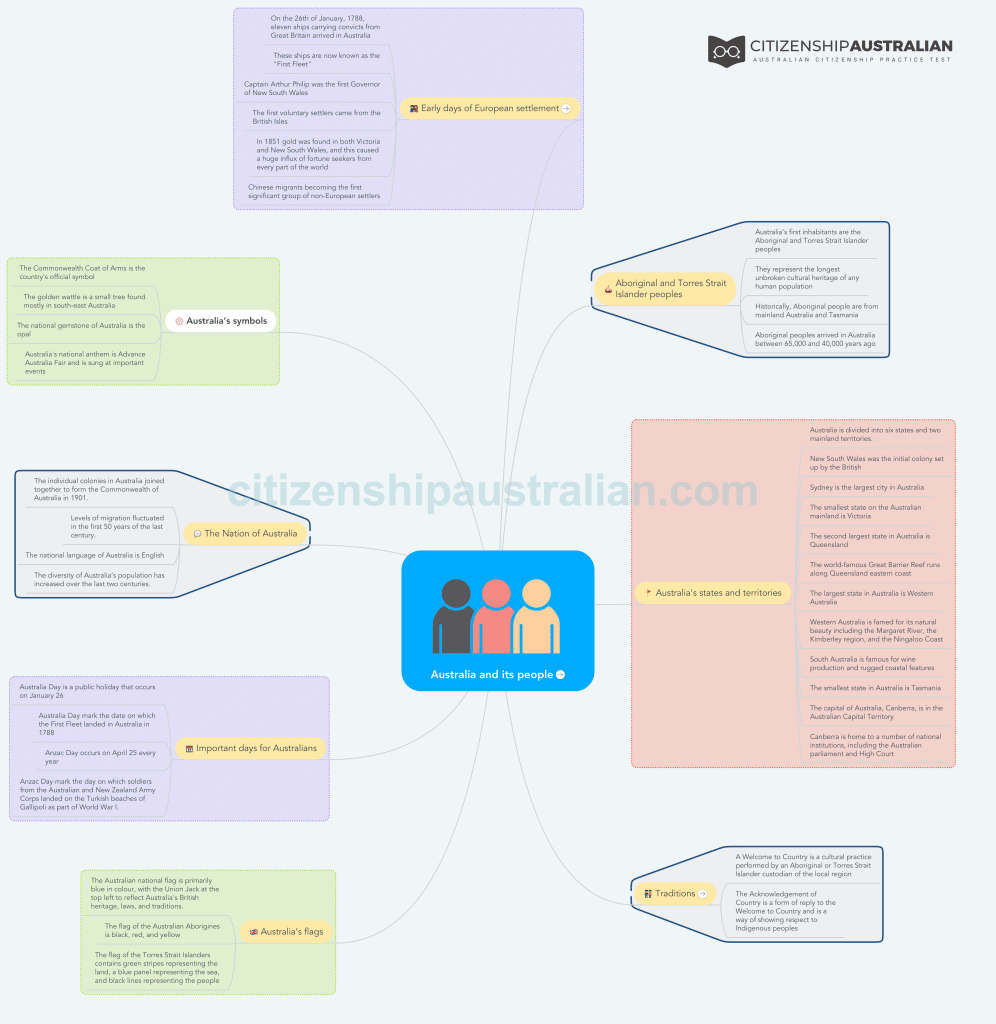1 Aboriginal and Torres Strait Islander peoples
1.1 Australia’s first inhabitants are the Aboriginal and Torres Strait Islander peoples
1.2 They represent the longest unbroken cultural heritage of any human population
1.3 Historically, Aboriginal people are from mainland Australia and Tasmania
1.4 Aboriginal peoples arrived in Australia between 65,000 and 40,000 years ago
2 Early days of European settlement
2.1 On the 26th of January, 1788, eleven ships carrying convicts from Great Britain arrived in Australia
2.2 These ships are now known as the “First Fleet”
2.3 Captain Arthur Philip was the first Governor of New South Wales
2.4 The first voluntary settlers came from the British Isles
2.5 In 1851 gold was found in both Victoria and New South Wales, and this caused a huge influx of fortune seekers from every part of the world
2.6 Chinese migrants becoming the first significant group of non-European settlers
3 The Nation of Australia
3.1 The individual colonies in Australia joined together to form the Commonwealth of Australia in 1901.
3.2 Levels of migration fluctuated in the first 50 years of the last century.
3.3 The national language of Australia is English
3.4 The diversity of Australia’s population has increased over the last two centuries.
4 Australia’s states and territories
4.1 Australia is divided into six states and two mainland territories.
4.2 New South Wales was the initial colony set up by the British
4.3 Sydney is the largest city in Australia
4.4 The smallest state on the Australian mainland is Victoria
4.5 The second largest state in Australia is Queensland
4.6 The world-famous Great Barrier Reef runs along Queensland eastern coast
4.7 The largest state in Australia is Western Australia
4.8 Western Australia is famed for its natural beauty including the Margaret River, the Kimberley region, and the Ningaloo Coast
4.9 South Australia is famous for wine production and rugged coastal features
4.10 The smallest state in Australia is Tasmania
4.11 The capital of Australia, Canberra, is in the Australian Capital Territory
4.12 Canberra is home to a number of national institutions, including the Australian parliament and High Court
5 Traditions
5.1 A Welcome to Country is a cultural practice performed by an Aboriginal or Torres Strait Islander custodian of the local region
5.2 The Acknowledgement of Country is a form of reply to the Welcome to Country and is a way of showing respect to Indigenous peoples
6 Important days for Australians
6.1 Australia Day is a public holiday that occurs on January 26
6.2 Australia Day mark the date on which the First Fleet landed in Australia in 1788
6.3 Anzac Day occurs on April 25 every year
6.4 Anzac Day mark the day on which soldiers from the Australian and New Zealand Army Corps landed on the Turkish beaches of Gallipoli as part of World War I.
7 Australia’s flags
7.1 The Australian national flag is primarily blue in colour, with the Union Jack at the top left to reflect Australia’s British heritage, laws, and traditions.
7.2 The flag of the Australian Aborigines is black, red, and yellow
7.3 The flag of the Torres Strait Islanders contains green stripes representing the land, a blue panel representing the sea, and black lines representing the people
8 Australia’s symbols
8.1 The Commonwealth Coat of Arms is the country’s official symbol
8.2 The golden wattle is a small tree found mostly in south-east Australia
8.3 The national gemstone of Australia is the opal
8.4 Australia’s national anthem is Advance Australia Fair and is sung at important events

